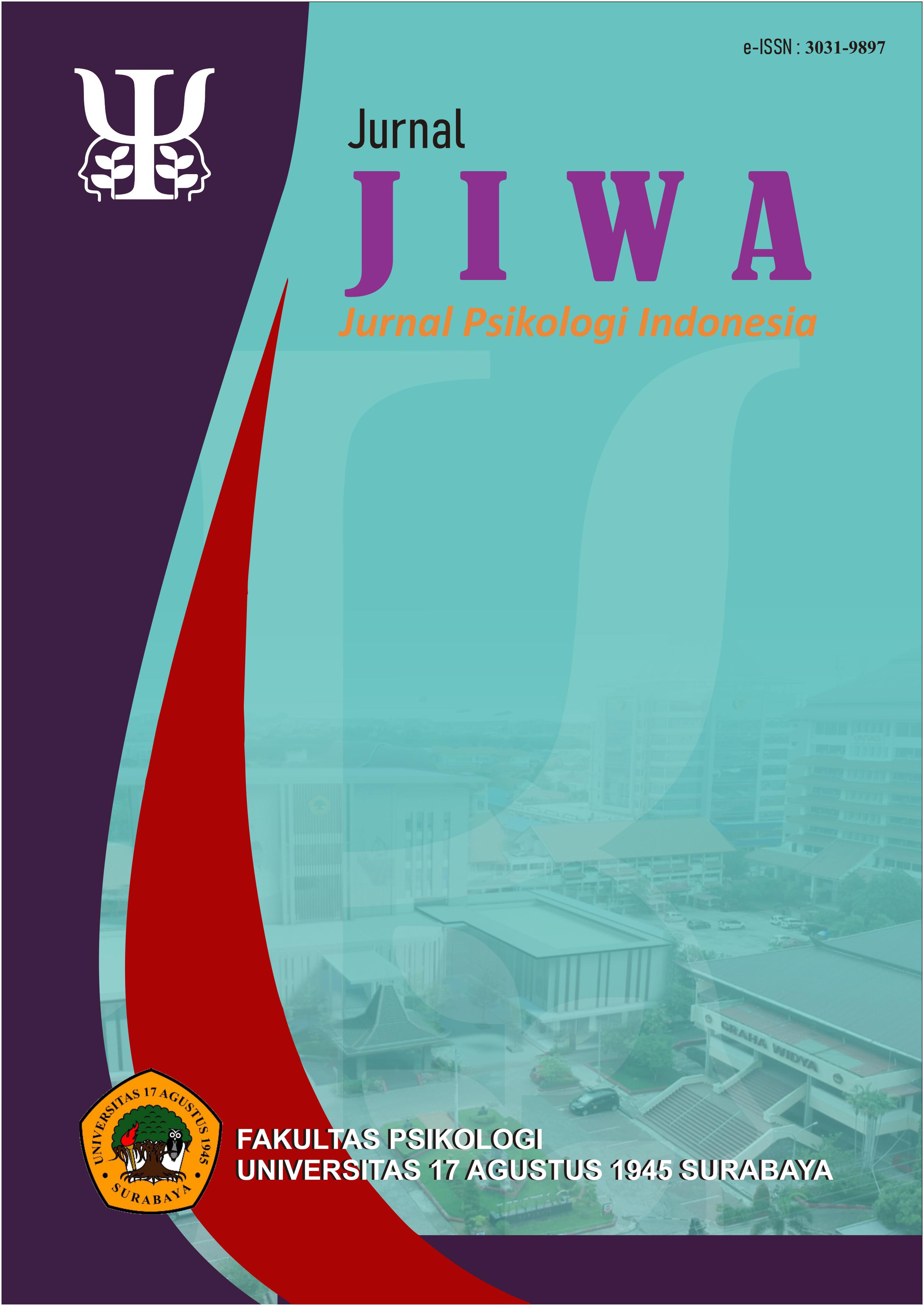Perbedaan Kepuasan Pernikahan Ditinjau dari Peran dalam Pernikahan pada Individu yang Menikah Muda
DOI:
https://doi.org/10.30996/jiwa.v2i2.11149Keywords:
marital satisfaction, young marriage, role in marriageAbstract
The phenomenon of divorce in couples who marry young is considered related to marital satisfaction. Marital satisfaction is both a husband and wife's subjective evaluation of marriage. One factor that affects marital satisfaction is the role in the marriage. This study used quantitative research methods with a comparative approach. This research aims to see differences in marital satisfaction in terms of roles in marriage in individuals who married young. Sampling using nonprobality sampling techniques with a total of 120 research respondents. Normality test using Kolmogorov-Smirnov and obtained significance value (p)=0.000 (p<0.05). The homogeneity test uses the Test of Homogeneity of Variances (Levene Test) and obtained a significance value p=0.062 (p>0.05). The hypothesis test was carried out using the Mann-Whitney technique and obtained a significance value (p)=0.046 (p<0.05). The results of the study showed that there were differences in marital satisfaction in terms of the role of marriage in individuals who married young.
Downloads
References
Batmaro, A. A. O., Ruliati, L. P., & Kiling, I. Y. (2020). Marriage satisfaction on young women with premarital pregnancy. Journal of Health and Behavioral Science, 2(3), 14–25.
Battersby, L. (2015). The survey says… women are less happy with their relationship then men are. Retrieved.
Bernard, J. (1972). (1982). The future of marriage. New Haven, CT: Yale University Press.
Bimo, W. (2010). Pengantar psikologi umum. Yogyakarta: CV Andi Offset, 156.
Coltrane, S. (2000). Research on household labor: Modeling and measuring the social embeddedness of routine family work. Journal of Marriage and Family, 62(4), 1208–1233.
Compton, W. C., & Hoffman, E. (2019). Positive psychology: The science of happiness and flourishing. Sage Publications.
Duvall, E. R. M., & Miller, B. C. (1985). Marriage and family development. (No Title).
Dwima, M. J. A. (2019). Pengaruh komunikasi efektif terhadap kepuasan pernikahan pada pasangan yang melakukan pernikahan dini. Cognicia, 7(4), 475–491.
Eunson, B. (2012). Communicating in the 21st century. (No Title).
Fard, M. K., Shahabi, R., & Zardkhaneh, S. A. (2013). Religiosity and marital satisfaction. Procedia-Social and Behavioral Sciences, 82, 307–311.
Fincham, F. D., Ajayi, C., & Beach, S. R. H. (2011). Spirituality and marital satisfaction in African American couples. Psychology of Religion and Spirituality, 3(4), 259.
Fowers, B. J., & Olson, D. H. (1993). ENRICH Marital Satisfaction Scale: A brief research and clinical tool. Journal of Family Psychology, 7(2), 176.
Gager, C. T., & Sanchez, L. (2003). Two as one? Couples’ perceptions of time spent together,
marital quality, and the risk of divorce. Journal of Family Issues, 24(1), 21–50.
Hurlock, E. B. (1996). Psikologi perkembangan: Suatu pendekatan sepanjang rentang kehidupan, terj Isti Widiyati,. In Jakarta: Erlangga.
Jackson, J. B., Miller, R. B., Oka, M., & Henry, R. G. (2014). Gender differences in marital satisfaction: A meta‐analysis. Journal of Marriage and Family, 76(1), 105–129.
Janiwarty, B., & Pieter, H. Z. (2013). Pendidikan psikologi untuk bidan suatu teori dan terapannya. Yogyakarta: Rapha Publishing.
Jose, O. A., & Alfons, V. (2007). Religiosity and forgiveness among first-married and remarried adults. Mental Health, Religion and Culture, 10(4), 379–394.
Juliano P, S. (2015). Komunikasi dan gender: Perbandingan gaya komunikasi dalam budaya maskulin dan feminim. JIPSI-Jurnal Ilmu Politik Dan Komunikasi UNIKOM, 5.
Kamo, Y. (1993). Determinants of marital satisfaction: A comparison of the United States and Japan. Journal of Social and Personal Relationships, 10(4), 551–568.
Lavner, J. A., Karney, B. R., & Bradbury, T. N. (2014). Relationship problems over the early years of marriage: Stability or change? Journal of Family Psychology, 28(6), 979.
Li, T., & Fung, H. H. (2011). The dynamic goal theory of marital satisfaction. Review of General Psychology, 15(3), 246–254.
Mappiare, A. (1983). Psikologi orang dewasa bagi penyesuaian dan pendidikan. Usaha Nasional.
Nindyasari, Y., & Herawati, T. (2018). The relation of emotional maturity, family interaction and marital satisfaction of early age married couples. Journal of Family Sciences, 3(2), 16–29.
Nugraha, W., & Malueka, N. (2023). Peran Intensitas Komunikasi Dan Dukungan Sosial Pasangan Terhadap Kepuasaan Perkawinan Suami/Istri Ditinjau Berdasarkan Jenis Kelamin. Jurnal Consulenza: Jurnal Bimbingan Konseling Dan Psikologi, 6(1), 97–108.
Oshio, T., Nozaki, K., & Kobayashi, M. (2013). Division of household labor and marital satisfaction in China, Japan, and Korea. Journal of Family and Economic Issues, 34, 211–223.
Papalia, D. E., Gross, D. L., & Feldman, R. D. (2003). Child development: A topical approach. McGraw-Hill Humanities, Social Sciences & World Languages.
Puspitawati, H. (2010). Persepsi peran gender terhadap pekerjaan domestik dan publik pada mahasiswa IPB. Yinyang: Jurnal Studi Islam Gender Dan Anak, 5(1), 17–34.
Rahmananda, R., Adiyanti, M. G., & Sari, E. P. (2022). Kepuasan Pernikahan pada Istri Generasi Milenial di Sepuluh Tahun Awal Pernikahan. Jurnal Ilmu Keluarga & Konsumen, 15(2), 102–116.
Raisah, P. (2023). Perbedaan Kepuasan Pernikahan Pada Suami Dan Istri Di Usia Awal Pernikahan Di Kabupaten Bireuen. UIN Ar-Raniry Banda Aceh.
Reevy, G. M., & Maslach, C. (2001). Use of social support: Gender and personality differences. Sex Roles, 44, 437–459.
Rif’atin, C., Eva, N., & Shanti, P. (2021). Perbedaan Kepuasan Pernikahan antara Suami dan Istri Ditinjau dari Pengungkapan Diri dan Cinta. Flourishing Journal, 1(4), 295–301.
Risandy, A. (2018). Pengaruh kepercayaan dan dukungan keluarga terhadap kebahagiaan pernikahan pada mahasiswa yang menikah muda. Fakultas Psikologi UIN Syarif Hidayatullah Jakarta.
Rostami, M., Taheri, A., Abdi, M., & Kermani, N. (2014). The effectiveness of instructing emotion-focused approach in improving the marital satisfaction in couples. Procedia-Social and Behavioral Sciences, 114, 693–698.
Santrock, J. W. (2011). Perkembangan anak edisi 7 jilid 2. In Terjemahan: Sarah Genis B) Jakarta: Erlangga (7th ed.). Erlangga.
Sari, M. I., Prabandari, Y. S., & Claramita, M. (2016). Physicians’ professionalism at primary care facilities from patients’ perspective: the importance of doctors’ communication skills. Journal of Family Medicine and Primary Care, 5(1), 56.
Srisusanti, S., & Zulkaida, A. (2013). Studi deskriptif mengenai faktor-faktor yang mempengaruhi kepuasan perkawinan pada istri. UG Journal, 7(6).
Sugiyono. (2015). Metode penelitian kombinasi (mixed methods). In Bandung: Alfabeta.
Supraba, D. (2022). Gambaran kepuasan pernikahan pasangan yang menikah dini ditinjau dari karakteristik subyek. Jurnal Psimawa, 5(1), 16–23.
Veronika, M., & Afdal, A. (2021). Analisis kepuasan pernikahan pada pasangan suami istri yang bekerja.
Yanti, Y., Hamidah, H., & Wiwita, W. (2018). Analisis faktor penyebab dan dampak pernikahan dini di kecamatan kandis kabupaten siak. Jurnal Ibu Dan Anak, 6(2), 96–103.







